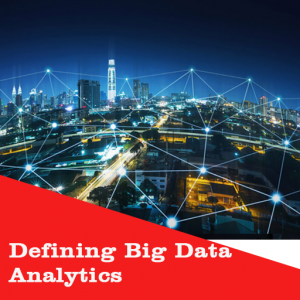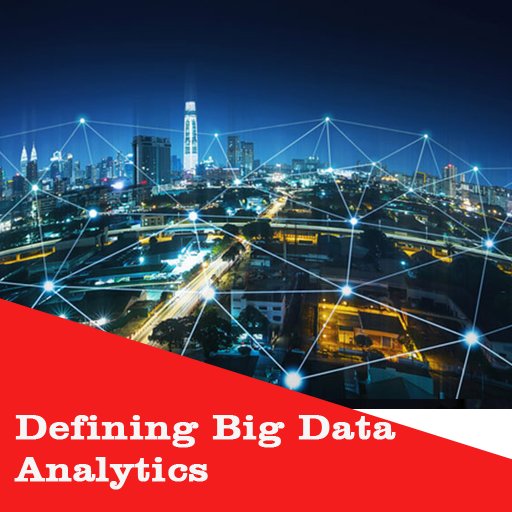Applications of Big Data Analytics
Big data analytics is a term that has been around for several years now. It is the process of analyzing and deriving insights from large and complex data sets, known as big data. With the exponential growth of data generated by various sources, it has become increasingly important for organizations to extract valuable information from this data in order to gain a competitive edge. In this article, we will define big data analytics, discuss its importance, and explore its various features. 
Understanding Big Data
Big data refers to the vast amounts of data that are generated by various sources such as social media platforms, online transactions, and internet-connected devices. This data is often unstructured, meaning it doesn’t fit neatly into a traditional database. As a result, big data requires special tools and techniques to store, process, and analyze it. In addition, big data has four key characteristics, which are commonly referred to as the 4Vs: – Volume: Big data is
characterized by its sheer volume, with data sets that range from terabytes to petabytes and beyond. – Velocity: Big data is generated at an incredible speed, with new data points being added every second. – Variety: Big data comes in various forms, including structured, semi-structured, and unstructured data. – Veracity: Big data can be noisy, inconsistent, and uncertain, making it difficult to draw accurate conclusions.
Analytics in the Context of Big Data
Analytics is the process of examining data to extract insights and draw conclusions. In the context of big data, analytics involves using advanced algorithms and statistical models to identify patterns, trends, and relationships within large and complex data sets. Big data analytics tools can be used to analyze data in real-time, allowing organizations to make informed decisions based on up-to-date information.
Applications of Big Data Analytics
Big data analytics has numerous applications across various industries, including healthcare, finance, retail, and manufacturing. In healthcare, big data analytics can be used to identify patterns and trends in patient data to improve diagnosis and treatment outcomes. In finance, big data analytics can be used to detect fraudulent transactions and identify investment
opportunities. In retail, big data analytics can be used to analyze customer behavior and preferences to improve marketing strategies and increase sales. In manufacturing, big data analytics can be used to optimize supply chain operations and improve product quality. In summary, big data analytics is the process of analyzing and deriving insights from large and complex data sets. Big data has four key characteristics – volume, velocity, variety, and veracity – which make it challenging to store, process, and analyze. Analytics in the context of
big data involves using advanced algorithms and statistical models to identify patterns, trends, and relationships within large data sets. Big data analytics has numerous applications across various industries, helping organizations gain valuable insights and make informed decisions based on up-to-date information.
Analytics in the Context of Big Data
In the era of digital transformation, the term “big data” has become synonymous with vast quantities of information and complex datasets. The analytics of big data encompasses a broad range of techniques and methodologies used to process, interpret, and extract valuable
insights from these enormous and diverse datasets. This article explores how analytics operates within the context of big data, highlighting the key methodologies, technologies, and applications that drive effective big data analytics.
1. Understanding Big Data Analytics
Overview: Big data analytics involves the use of sophisticated tools and techniques to analyze large and varied data sets that traditional data processing methods cannot handle efficiently. This type of analytics aims to uncover hidden patterns, correlations, and insights that can guide decision-making and strategic planning.
Key Components:
- Volume: Refers to the sheer amount of data collected from various sources.
- Velocity: Deals with the speed at which data is generated and needs to be processed.
- Variety: Addresses the different types of data, such as structured, semi-structured, and unstructured data.
- Veracity: Involves ensuring the accuracy and trustworthiness of data.
2. Key Methodologies in Big Data Analytics
1. Descriptive Analytics
Overview: Descriptive analytics focuses on summarizing historical data to understand what has happened in the past. It provides insights into past performance and trends through data aggregation and reporting.
Techniques:
- Data Aggregation: Collecting and summarizing data from multiple sources to provide a comprehensive view.
- Reporting Tools: Using dashboards and reports to visualize historical data trends and performance metrics.
Example: Retailers use descriptive analytics to analyze sales data from previous quarters to identify seasonal trends and product performance.
2. Diagnostic Analytics
Overview: Diagnostic analytics aims to understand the causes of past events. It goes beyond what happened to explore why it happened by identifying patterns and correlations.
Techniques:
- Correlation Analysis: Examining relationships between different variables to uncover potential causes.
- Root Cause Analysis: Investigating the underlying factors that contributed to specific outcomes.
Example: A company experiencing a decline in customer satisfaction might use diagnostic analytics to determine whether the issue is related to product quality, service delays, or other factors.
3. Predictive Analytics
Overview: Predictive analytics uses historical data and statistical algorithms to forecast future trends and behaviors. It helps organizations anticipate potential outcomes and make proactive decisions.
Techniques:
- Statistical Modeling: Building models based on historical data to predict future events.
- Machine Learning: Employing algorithms that improve their predictive accuracy over time by learning from new data.
Example: Financial institutions use predictive analytics to assess credit risk and forecast loan default probabilities based on customers’ financial history.
4. Prescriptive Analytics
Overview: Prescriptive analytics provides actionable recommendations on how to address potential future scenarios. It combines predictive models with optimization techniques to suggest the best course of action.
Techniques:
- Optimization Algorithms: Identifying the best strategies or decisions to achieve desired outcomes.
- Simulation Models: Creating simulations to evaluate the impact of different decisions or actions.
Example: Supply chain managers use prescriptive analytics to optimize inventory levels and delivery schedules to minimize costs and meet customer demand.
5. Cognitive Analytics
Overview: Cognitive analytics involves advanced techniques that simulate human thought processes to understand complex patterns and make sense of unstructured data. It combines artificial intelligence and natural language processing.
Techniques:
- Natural Language Processing (NLP): Analyzing and interpreting human language data from sources like social media and customer feedback.
- Sentiment Analysis: Evaluating the sentiment expressed in text data to gauge customer opinions and attitudes.
Example: Businesses use cognitive analytics to analyze customer reviews and social media posts, gaining insights into customer sentiment and feedback.
3. Technologies Enabling Big Data Analytics
1. Big Data Frameworks
Overview: Big data frameworks provide the infrastructure needed to process and analyze large volumes of data efficiently. They enable distributed data processing across multiple nodes.
Key Frameworks:
- Hadoop: An open-source framework for distributed storage and processing of large datasets using a cluster of computers.
- Apache Spark: A unified analytics engine that supports in-memory data processing for faster data analysis.
2. Data Warehousing and Storage Solutions
Overview: Data warehousing solutions are designed to store large volumes of data from various sources, enabling efficient querying and analysis.
Key Solutions:
- Data Lakes: Centralized repositories that store structured and unstructured data at scale.
- Columnar Databases: Databases optimized for reading and writing large volumes of data in a column-oriented format.
3. Data Visualization Tools
Overview: Data visualization tools help users interpret complex data through graphical representations, making it easier to identify patterns and trends.
Key Tools:
- Tableau: A popular data visualization tool that allows users to create interactive and shareable dashboards.
- Power BI: A Microsoft tool for creating detailed reports and visualizations with integration to various data sources.
4. Applications of Big Data Analytics
1. Healthcare
Overview: Big data analytics is transforming healthcare by improving patient outcomes, optimizing operations, and advancing medical research.
Applications:
- Predictive Analytics: Forecasting patient admission rates and disease outbreaks.
- Personalized Medicine: Analyzing genetic and clinical data to tailor treatments to individual patients.
2. Retail
Overview: Retailers use big data analytics to enhance customer experiences, optimize inventory, and boost sales.
Applications:
- Customer Segmentation: Analyzing purchase history to create targeted marketing campaigns.
- Supply Chain Optimization: Managing inventory levels and predicting demand to reduce costs.
3. Finance
Overview: Financial institutions leverage big data analytics for risk management, fraud detection, and investment strategies.
Applications:
- Fraud Detection: Identifying unusual transaction patterns to prevent financial fraud.
- Algorithmic Trading: Using predictive models to execute trades based on market data.
Conclusion
Big data analytics encompasses a range of methodologies, technologies, and applications designed to make sense of vast and complex datasets. From descriptive and diagnostic analytics to predictive, prescriptive, and cognitive analytics, each approach offers unique insights and capabilities. Leveraging advanced technologies and frameworks enables
organizations to process and analyze data efficiently, while data visualization tools help translate complex findings into actionable intelligence. Understanding and harnessing these features of big data analytics allows organizations to drive innovation, improve decision-making, and maintain a competitive edge in an increasingly data-driven world.
